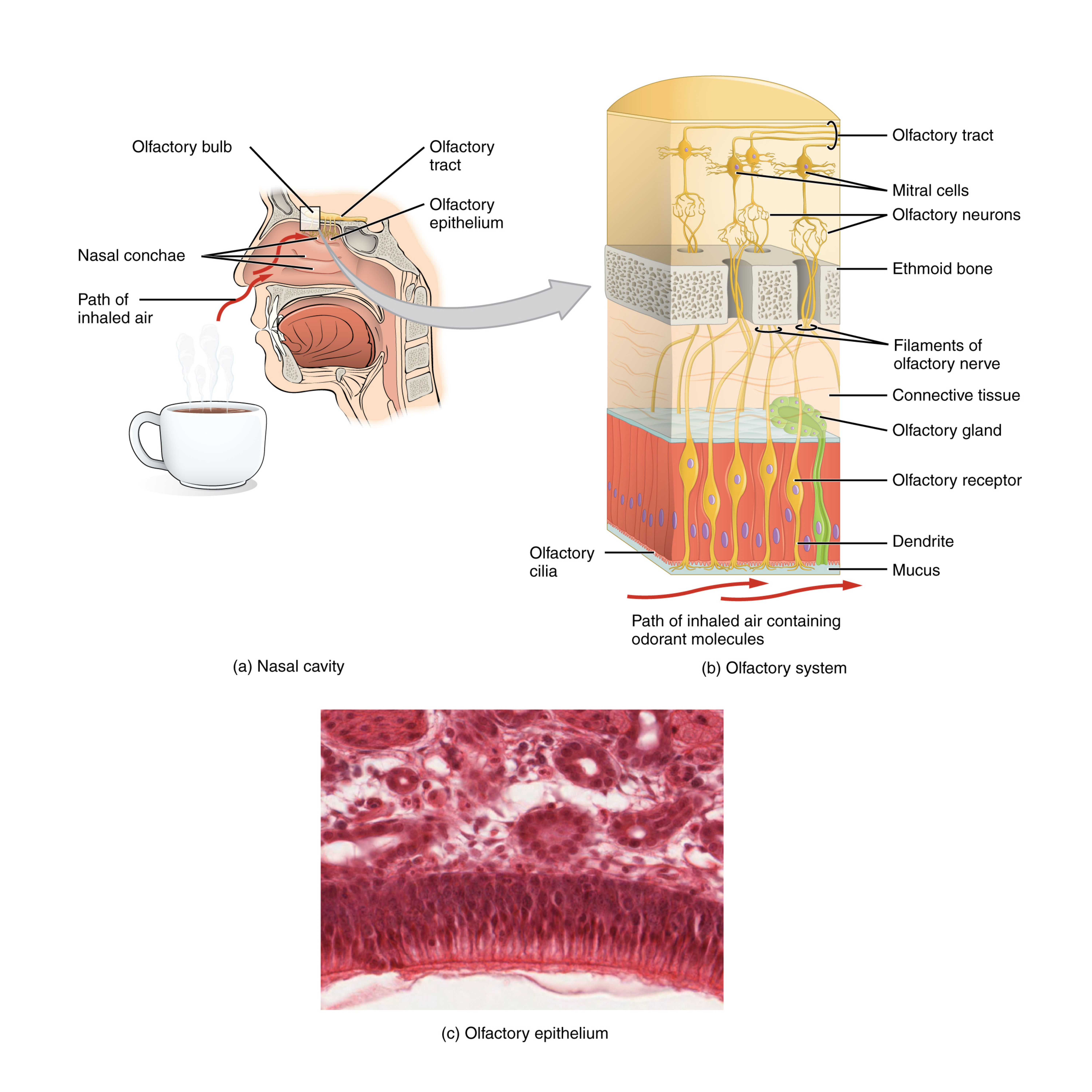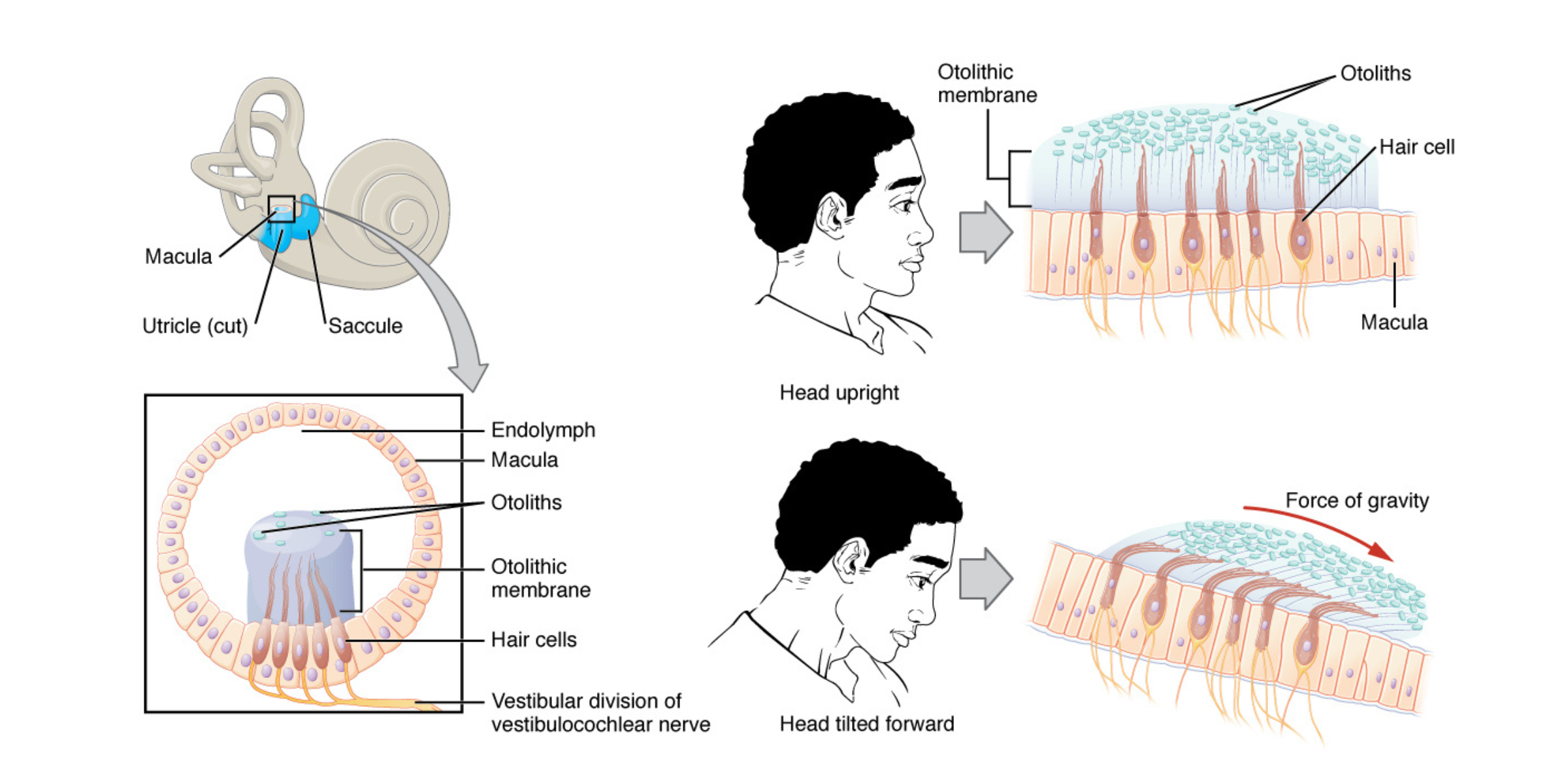Similarly to taste, the sense of olfaction (smell) responds to chemical stimuli.
Within the superior nasal cavity is a specialized region called the olfactory epithelium, which houses olfactory receptor neurons—a type of bipolar sensory neuron. From the apical surface of this tissue, the neurons have dendrites that extend into the surrounding mucus.
When air is inhaled, odorant molecules dissolve in the mucus and bind to carrier proteins that help deliver them to the olfactory dendrites. These odorants then bind to G protein–coupled receptors on the dendritic membrane, creating a graded membrane potential.
The axon of each olfactory neuron projects through an olfactory foramen in the cribriform plate of the ethmoid bone to reach the brain. Groups of these axons form the olfactory tract, which connects to the olfactory bulb on the ventral side of the frontal lobe.
From there, signals travel to several brain regions, including the cerebrum—specifically the primary olfactory cortex located in the inferior and medial regions of the temporal lobe—and to parts of the limbic system and hypothalamus, where smells can trigger emotional memories. Notably, smell is unique in that it does not synapse in the thalamus before reaching the cerebral cortex, which helps explain why odors strongly evoke emotions and memories.
The nasal epithelium, including the olfactory cells, is exposed to potentially harmful airborne chemicals. As a result, olfactory neurons are routinely replaced. When new neurons form, their axons grow along existing pathways in the cranial nerve to reconnect with targets in the olfactory bulb.

Pheromones are chemical signals released by one member of a species that affect the behavior or physiology of another member of the same species.
Pheromones serve multiple functions:
Pheromone mechanism of action
Types of pheromones
In humans, the potential effects of pheromones on attraction, reproduction, and mood regulation continue to be researched.
Kinesthesia is the conscious perception of body movement, distinct from proprioception, which primarily detects the static position of the body.
Components: Kinesthesia depends on sensory receptors in muscles, tendons, and joints that respond to:
Distinction from proprioception:
Neural pathways:
Integration with other senses:
In addition to hearing, the inner ear is crucial for equilibrium (balance). Specialized hair cells with stereocilia detect head position, head movement, and overall motion.
These cells reside in the vestibule of the inner ear, with the utricle and saccule detecting head position, and the semicircular canals detecting head rotation. Signals from the vestibular ganglion travel via the vestibulocochlear nerve to the brain stem and cerebellum.
Within the utricle and saccule, macula tissue (plural: maculae) contains hair cells supported by surrounding cells. The stereocilia extend into the otolithic membrane, a viscous layer topped with calcium carbonate crystals called otoliths.
Because the otolithic membrane is weighted by these crystals, it shifts when the head tilts, bending the stereocilia and causing differential depolarization of the hair cells. The brain interprets these signals to determine head orientation.

The semicircular canals are three looped structures extending from the vestibule: one aligned horizontally and two oriented vertically.
The base of each canal widens into an ampulla, which houses the hair cells that detect rotational motion (e.g., turning the head side to side). The stereocilia project into the cupula, a membrane that moves in response to fluid lag when the head rotates. This deflection of the cupula bends the stereocilia, generating a signal that indicates the direction and speed of head movement.
By comparing information from all three semicircular canals, the vestibular system interprets movement in three-dimensional space.
Sign up for free to take 5 quiz questions on this topic